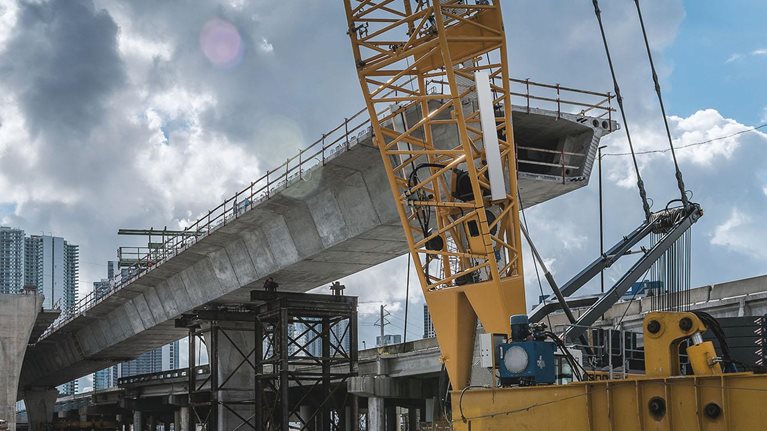Moving toward net-zero emissions is an urgent priority for companies today, and it is creating a massive wave of projects driven by sustainability concerns. As we discuss in an earlier article, total capital spending will reach an estimated $130 trillion by 2050.1 The bulk of this amount will go into projects that aim to reduce the buildup of the greenhouse-gas (GHG) emissions that contribute to global warming and trigger climate change.2
But good intentions alone won’t get the job done. The current capital project environment is largely unprepared to tackle the sheer size and scope of decarbonization and infrastructure construction projects. And time is running out to avert the worst impacts of climate change. The biggest challenge for senior leaders is getting sustainable assets into action fast enough. This involves limiting global warming to 1.5˚C above preindustrial levels, meaning that carbon dioxide (CO2) and other GHG emissions would need to decrease by 45 percent by 2030 and reach net zero by around 2050 and 2070, respectively.
First movers toward net zero can capture significant advantages—for example, they can gain better access to talent and financing, form partnerships to drive value from digital and renewable solutions, and enjoy increased support from investors and customers. But at today’s pace of project delivery, companies are typically not able to achieve net-zero targets on schedule. Frequent supply chain disruptions compound a growing scarcity of skilled labor, materials, and financing. The requirements of stakeholders such as governments, regulators, developers, and suppliers also need to be considered. In this environment, large capital ventures can take up to seven years to complete and suffer delays of two years or more; complex power-generation projects such as nuclear plants can take up to 15 years.
In this article, we discuss strategies for leaders to speed up infrastructure projects that need to be executed with sustainability in mind. Tactics such as standardizing design, using digital tools, reskilling appropriately, forming collaborative partnerships with stakeholders, and installing capital-expenditure-management systems can go a long way toward accelerating project delivery.
Sustainable projects face unique challenges
Speed in executing capital projects is of paramount importance to achieving sustainable-development goals. But costs have risen dramatically in the past two years. In particular, commodity prices are up 20 to 90 percent above prepandemic levels, driven by inflation and supply chain challenges.3 The global capital allocation required to meet decarbonization goals between now and 2050 would need to be about 60 percent greater than it is today, rising by $3.5 trillion annually on average. Many sectors will see a spending increase of 57 to 65 percent between 2022 and 2027 compared with the previous five-year period.
The unique needs of sustainability ventures also introduce considerations that don’t apply to traditional capital projects. Whether retrofits or new builds, sustainability projects often use new technologies that may be unproven or lack detailed design. Some types of infrastructure are highly interdependent on others, such that constructing one project requires carrying out others to support it. For example, building a hydrogen ecosystem in the transportation industry would require, at a minimum, retrofitters, refueling stations, and increased capacity for hydrogen production. In addition, the construction industry faces some capacity challenges. Faltering labor productivity growth (less than 1 percent a year over the past 20 years) and long time frames to obtain permits remain persistent problems (exhibit). Civil infrastructure and industrial and manufacturing plants are roughly at maximum capacity; many have experienced very little modernization in the past several years.

Image description:
Two horizontal bar charts side-by-side illustrate how global operations in the same industry that span multiple countries may face vastly different time frames for obtaining permits.
The left-hand chart shows the average median number of days to complete a construction permit in 2020 by country. The right-hand chart shows the number of interactions needed to obtain a construction permit in 2020 by country. The countries shown are France, Russia, Germany, China, Japan, UK, US, and South Korea.
Figures for the median number of days to complete a construction permit range from 27.5 days for South Korea to 213 days for France. Figures for the number of interactions needed to obtain a construction permit range from 9 for France, Germany, and UK to 18 for China.
End of image description.
The most serious constraint may be the shortage of construction labor. For example, the United States will need about 168,000 construction laborers each year from now until 2030.4 Germany faces a serious labor shortage, with a net number of nearly two million open jobs.5 Even as the growth of new jobs outstrips the rate of new hires, a further complication arises: changing workforce skills and capabilities. Over the past decade, the median age of construction workers has risen, with more than one in five aged 55 and older—particularly problematic for an industry with an average retirement age of 61.6 The shortage of experienced people to train junior entrants can hurt an industry that relies heavily on on-the-job training and experience to acquire skills and capabilities. The net-zero workforce—the generation working to meet climate change goals—needs to be much larger, better skilled, and more productive than the workforce of today. This presents a significant opportunity for companies to upskill workers and drive equitable economic opportunities, as well as to use forward-contracting methods and to manage resources within partnership ecosystems.
Prioritize speed over cost
Historically, capital projects have typically prioritized cost over speed of delivery, unless the value of what is being delivered justifies an accelerated timeline. This is often the case for sustainable capital projects, where establishing new processes may cost more initially but will pay off in faster delivery and, potentially, better outcomes for project owners and investors. Companies and project developers may want to consider the following critical steps to shorten project timelines.
Rethink design and engineering
This step alone can raise productivity by 8 to 10 percent. Standardizing design enables rapid upskilling, uniform specifications, and lean construction that helps to reduce waste and improve efficiency. Sustainability projects that rely on less mature technologies may need unique specifications, but owners can make efforts early on to reduce overdesign and maximize the number of standardized or modularized components.
Shifting to modular construction can compress schedules by 20 to 50 percent, with the added benefit of improving delivery times. Modular and prefabricated construction for both residential and nonresidential building is having some impact in the European Union, as well as in Canada, Japan, South Korea, and the United States. However, even in the fastest-growing scenario, modular penetration is still below 10 percent, whereas in civil construction the penetration of prefabrication is expected to remain around 20 to 30 percent, as it is today.
The experience of an international mining company shows the efficacy of using design to accelerate project delivery. Moving to net zero relies heavily on the mining and metals sector to provide raw materials for sustainability projects. Speed in getting new projects online is even more important when producing the raw materials necessary for decarbonization projects, as these inputs drive the massive technological transition needed for sustainability. The mining company changed the design and execution of its first and second stages of front-end planning to shorten overall project duration. Using the minimum-technical-solution approach, the team reduced excavation volume significantly via a new tunnel cross-section and layout that shortened the overall construction time. It adjusted the construction methodology by using a mix of drill and blast mining and tunnel-boring machines to remove the first third of the tunnel’s length from the project’s critical path.
Would you like to learn more about our Operations Practice?
Reduce project variability
Our research has found that project complexity, data quality, execution capabilities, and mindsets are usually the root causes of project variability, or the extent of deviation from the plan. Improving the project production plan with advanced analytics and targeted optimization can improve the project schedule and cost performance by 30 to 50 percent.
A leading solar engineering company recognized that traditional schedule- and earned-value-based progress monitoring tools weren’t providing the granular and real-time insights that project leaders needed to manage projects such as manufacturing assembly lines. By adopting a suite of digital tools—including equipping crew leaders with tablets, geotagging key materials, and providing radio-frequency-identification tags for material tracking and workforce time keeping—the company set up the foundation for real-time information flow and data collection. A “control tower” was then implemented, integrating these insights into real-time dashboards that allowed for rapid decision making, surfacing of variability across sites and crews, and integration with project schedules and resource curves to anticipate future impact and simplify monthly reporting. Such transparency helps redirect efforts where they are most needed and boosts trust and cooperation, thus enhancing project productivity.
Deploy digital and analytical tools
Using digital analytics allows for real-time, data-driven decision making and can minimize wasted interactions when designing and delivering a project. For example, a collaborative digital platform could enable direct design editing, review, and approval across stakeholders, promoting real-time collaboration, reducing waiting time and defects, and improving onsite productivity.
Sustainability projects are often complex, involving many specialized trades and complicated systems integration. Traditional scheduling software could not provide the insights that a leading industrials player needed to create a high-quality resource-loaded schedule. The company introduced new digital tools that enabled generative scheduling, which could model the impact of various construction strategies (for example, build sequence, design choices, and access to the project management system). Before using this analytical approach, the company had considered adding structural overtime and more labor to the site, but the generative-scheduling model tested millions of options and discovered a counterintuitive approach that reduced cost and accelerated the schedule. These digital tools proved that by reallocating crews to nonobvious work areas and by completing the work in a different sequence, the project would end earlier and save valuable time to market in a competitive industry.
Promote collaborative partnerships
To promote speed of delivery, cooperation among stakeholders is essential. A collaborative partnership aims to maximize the expertise and alignment of all parties so that everyone is equally motivated to guarantee on-time delivery. There are six essential elements to most collaborative contracts:
- a defined period prior to execution of the final agreement
- a single contract that applies to all the delivery partners
- shared risk and shared incentives among all parties
- a no-fault clause whereby members forfeit rights to claims against one another
- a joint management structure to govern the project
- transparency and equal access to all costs and other project information
Establish an owner’s team capable of driving performance
Given their scale, complexity, and risk, sustainability projects can pose a unique challenge for owners. Even if all parties have a strong track record of on-time delivery, it helps to have a capable owner’s team that can stay focused on full-asset optimization and delivery, as well as anticipate and address issues, ensuring better project outcomes. Leaders should set up an appropriate organizational structure and governance to monitor and address risks and consider a regular and well-resourced cadence of reviews of key metrics such as commodity prices, skill availability, and other choke points in the ecosystem.
Develop a rigorous procurement and delivery model
To ensure that contract and procurement interventions both create value and streamline the speed of project delivery, organizations can design these interventions early in the project. We see five steps as critical:
- Define a procurement operating model and governance anchored on the key goals of balancing value and environmental impact.
-
Create a contract packaging strategy tied to project delivery and launch proactive sourcing strategies to better identify and mitigate recent market challenges—for example:
- Introduce alternative suppliers to lower the risk of exposure to a limited range of suppliers.
- Connect spending to indexes where applicable.
- Aggregate spending to broaden the supply base.
- Negotiate based on “cleansheets” (calculations of the cost of each step during the creation of a product, component, or service) supported by data-driven market intelligence.
- Deploy labor contracting strategies to attract, train, and retain required labor in overheated labor markets.
- Include a view on net emissions from the construction supply chain when selecting vendors (for example, the vendor’s supplier base, manufacturing emissions, transportation impact, or use of electric construction equipment).
- Standardize and optimize procurement tools and processes to support market intelligence, vendor identification, request-for-documents processes, negotiations, contract management, emissions impact, and feedback for new sourcing strategies and projects.
- Set specific cost and price benchmarks that are tailored to project conditions (for example, include inflation in project estimates) and allow for environmental impact to be considered.

Capital investment is about to surge: Are your operations ready?
Navigate an intricate maze of stakeholders
Today’s global stakeholder environment is incredibly complex and can cause major project delays if not managed properly. Stakeholders are vital to obtaining permits and licenses, making decisions, and providing approvals and sign-offs. It is essential for project developers to understand stakeholders’ agendas and concerns, assign a leader to manage the relationship, identify risks and guardrails, and set up a communication strategy. For example, one company identified some suppliers as critical to the project. The company hired former employees of those suppliers and charged them with building the suppliers’ trust and working with them to accelerate the manufacturing schedule.
For their part, governments and regulators—critical stakeholders—might consider the following actions to accelerate capital project completion:
- Improve the efficiency and responsiveness of the permitting process. It can take months or even years to secure permits for construction. Governments can simplify the process by clearly defining requirements for applicants and by creating an efficient and user-friendly one-stop shop for permits. Some governments have made strides in this area: for example, the New South Wales government in Australia has developed a process to streamline complex project assessments to less than a year.7
- Invest in education and professional training to reskill for net-zero jobs. In a decarbonized economy, jobs in resource-intensive sectors such as agriculture or oil and gas may decline. Governments can help ensure a smooth transition to sectors gaining jobs in the net-zero path by investing in reskilling.8 For example, in Singapore, a government-funded reskilling program enables all Singaporeans aged 25 and older to receive 500 Singapore dollars (about $356) a year; individuals can accumulate credits as the government provides periodic top-ups.9 In Louisville, Kentucky, a coalition of public and private organizations offers a 30-day upskilling program of free courses in areas such as data analytics, software engineering, and digital marketing, with a pathway for employment at local companies.
- Support research and innovation. Governments may want to consider financing fundamental research and sharing research and innovation in open source. For example, the EnergyPlus software developed by the US Department of Energy is an open-source building-energy-modeling simulator that can help with building decarbonization and is used widely in the industry. Only a limited number of existing technologies can support the net-zero pathway, and substantial deployment of new technologies—such as long-duration energy storage—will take time because of the human and industrial capacity needed to achieve it.10 Governments should consider planning for this well in advance, as the market share of new technologies may later become limited.
- Adapt and develop a fact-based regulatory framework. Cities have a key role to play in fighting climate change. Urban-planning strategy has an obvious impact on CO2 emissions from mobility but also has the potential to address the urban heat island (UHI) effect by modifying albedo—the light reflected by a body or surface.11 While all regulations need periodic review and updating, public regulators should consider providing visibility on upcoming changes so that developers with ongoing projects can anticipate the impact of revised regulations on capital project delivery.
- Be an inspirational public buyer. Public-infrastructure contracts tend to favor the cheapest offer rather than the one with the best environmental impact. By adopting green public-procurement methods, governments can inspire private- and public-sector purchasers of products and services to do the same.12 Although green public-procurement methods can be complex, they can contribute to a more sustainable marketplace, help communities thrive, and help to control some of the worst effects of climate change.13
- Promote collaboration and standardization across countries. Given the extreme complexity of regulations on sustainability, regulators can benefit from joint standards among countries and regulatory regimes. For example, various governments in Europe are working on a joint regulatory review of France’s Nuward small-modular-reactor (SMR) design.14 The Nuward SMR is expected to replace old high-CO2-emitting coal, oil, and gas plants around the world and support other applications such as hydrogen production and urban and district heating or desalination. The joint review would shift away from an individual project perspective to serial production in multiple countries and harmonization of SMR regulations. In another move toward standardization, the US government is proposing minimum standards and requirements for electric-vehicle charging infrastructure as part of a $5 billion government-funded initiative.15
Capital projects have never been as much in the limelight as they are today. But market headwinds and other structural constraints have brought about steep increases in project costs, making it essential for companies to take a step back and review their options—especially because the performance markers will continue to be return on invested capital, even for new and unproven sustainability-driven ventures. At the same time, the timelines for project delivery have never been tighter. Winning organizations will be able to balance cost and speed without losing their focus on the ultimate objective: getting to net zero.




